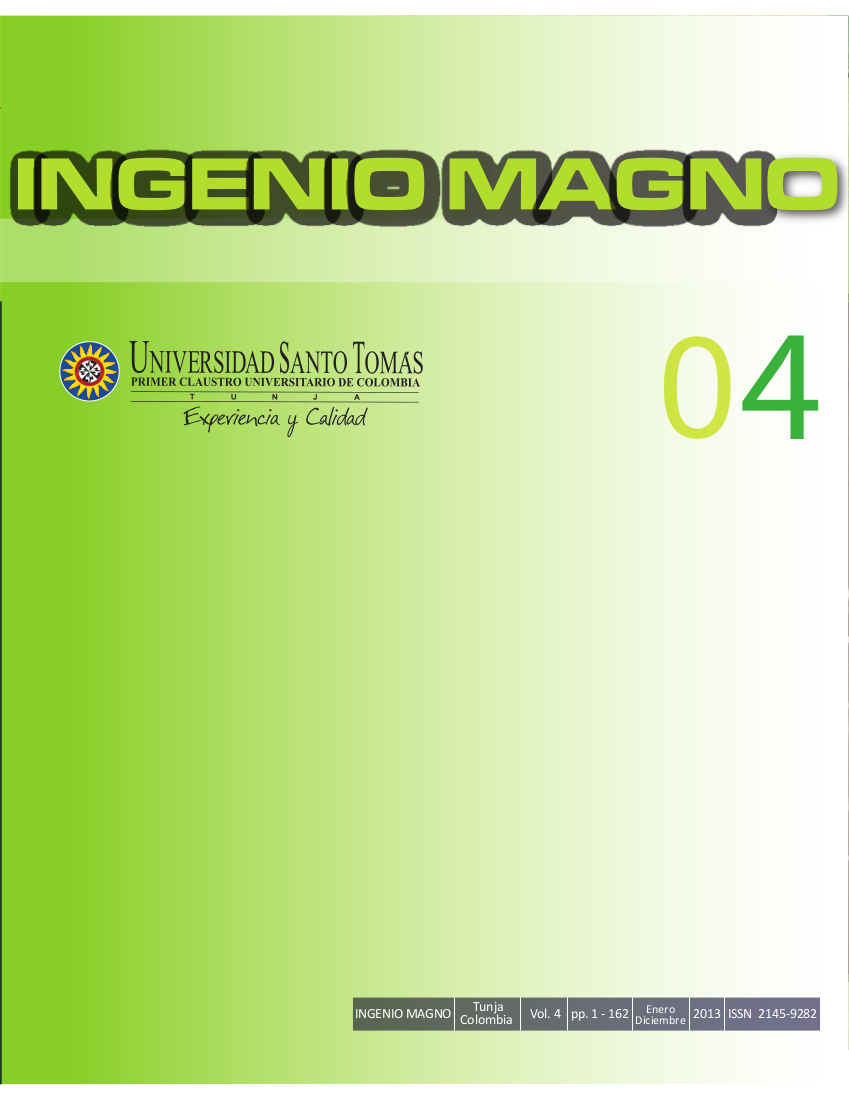Comercio colaborativo como alternativa de competitividad en empresas de la cadena de valor metalmecánica de Sogamoso
Main Article Content
Abstract
Downloads
Article Details
DECLARATION OF ORGINIALITY OF SUBMITTED ARTICLE
With this document, I/We certify that the article submitted for possible publication in the institutional journal INGENIO MAGNO of the Research Center Alberto Magno CIIAM of the University Santo Tomás, Tunja campus, is entirely of my(our) own writing, and is a product of my(our) direct intellectual contribution to knowledge.
All data and references to completed publications are duly identified with their respective bibliographical entries and in the citations thus highlighted. If any adjustment or correction is needed, I(we) will contact the journal authorities in advance.
Due to that stated above, I(we) declare that the entirety of the submitted material is in accordance with applicable laws regarding intellectual and industrial property, and therefore, I(we) hold myself(ourselves) responsible for any complaint related to it.
If the submitted article is published, I(we) declare that I(we) fully relinquish publishing rights of the article to the University Santo Tomás, Tunja campus. As remuneration for this relinquishment of rights, I(we) declare my(our) agreement to receive two (2) copies of the edition of the journal in which my(our) article appears.
References
García, J. G. (2002). “Liberalización, cambio estructural y crecimiento económico en Colombia.” Cuadernos de Economía.
ANDI, A. N. d. I. d. C. (2011). “Industria metalmecánica de América Latina en creciente amenaza por competencia China.” Retrieved 23/08/2011, from http://www.andi.com.co/pages/prensa/comunicados_prensa_detalle.aspx?Id=282.
Gulati, R. (1998). Alliances and Networks.” Strategic Management Journal 19: 293-317.
Hernández Sampieri, R., C. C. Fernández, et al. (2010). Metodología de la Investigación. México, D.F., McGraw Hill.
Kim, D. (2006). “Process chain: A new paradigm of collaborative commerce and synchronized supply chain “ Business Horizons 49(5): 359-367.
Chang, H. H. and I. C. Wang (2011). “Enterprise Information Portals in support of business process, design teams and collaborative commerce performance.” International Journal of Information Management 31(2): 171-182.
Chen, M., D. Zhang, et al. (2007). “Empowering collaborative commerce with Web services enabled business process management systems.” Decision Support Business 43: 530-546.
La República (2013, Abril 10). “Sidoc, Sidenal, Paz del Río y Gerdau Diaco se retiran de Fedemetal". http://www.larepublica.co/empresas/sidoc-sidenal-pazdelr%C3%ADo-y-gerdau-diaco-se-retiran-de-fedemetal_35941
Chung-Sheng, L. (2006). Enterprise Information Mashup and Real Time Business Assurance for Global Collaboration. Collaborative Computing: Networking, Applications and Worksharing Atlanta, GA.
Laso, I. and M. Iglesias (2002). Internet, Comercio Colaborativo y mComercio: Nuevos Modelos de Negocio. Madrid, Mundi-Prensa Libros, s.a.
Li, E., T. Du, et al. (2007). “Access control in collaborative commerce.” Decision Support Business 43: 675-685.
Li, L. (2012). “Effects on enterprise technology on supply chain collaboration: analysis of China-linked supply chain.” Enterprise Information Systems 6(1): 55-77.
López Aristizábal, N. (2005). Identificación de estrategias de mercados meta de los sectores metalmecánico, textil - confecciones y alimentos de la ciudad de Manizales. Facultad de Ciencias y Administración. Manizales, Universidad Nacional de Colombia. Magíster en Administración: 359.
Mingers, J. (2006). Realising systems thinking: Knowledge and action in management science. New York, Springer.
Mingers, J. (2010). Multimethodology. Wiley Encyclopedia of Operations Research and Management Science. Canterbury, John Wiley & Sons, Inc.
Miskinis, A. and B. Reinbold (2010). “Investments of German MNEs into production networks in Central European and Baltic states.” Technological and Economic Development of Economy 16(4): 717-735.
Montoya, L. A. and I. A. Montoya (2012). Metáforas Biológicas aplicadas a las organizaciones. Bogotá. Universidad Nacional de Colombia
Park, H., W. Suh, et al. (2004). “A role-driven component-oriented methodology for developing collaborative commerce systems.” Information and Software Technology 46(12): 819-837.
Pinilla, J. C. (2012). Caracterización del sector industrial de Sogamoso-Parque Industrial, base para la formulación de programas y proyectos de fortalecimiento empresarial. Universidad de Boyacá Sogamoso: Facultad de Ciencias Administrativas y Contables.
Planeación, O. A. (2008). Plan Territorial de Salud 2008-2011. Recuperado el 23 de Agosto de 2012, de Plan Territorial de Salud 2008-2011: http://www.sogamoso-boyaca.gov.co/apcaa-files/65616664353566303162646663663062/Plan_Territorial_de_Salud.pdf
Planeación, O. A. (2010). Plan Territorial de Salud 2010-2011. Recuperado el 23 de Agosto de 2012, de Plan Territorial de Salud 2010-2011: http://www.sogamoso-boyaca.gov.co/apcaa-files/36316166393539633236346635653330/PLAN_TERRITORIAL_DE_SALUD_2010_2011.pdf
Tamayo Arias, J., J. C. Higuita, et al. (2010). “Funcionalidades del Comercio Colaborativo en las Empresas Logísticas y su Decisión de Tercerización“ Cuadernos de Administración 23(41): 81-105.
Tan, K. C. (2001). “A framework of supply chain management literature.” European Journal of Purchasing & Supply Management 7: 39-48.
Velosa, G. J. (2011). Aproximación del Modelo Metodológico sobre Capacidad Tecnológica para las PYMES del Sector Metalmecánico Colombiano. Facultad de Ingeniería - Maestría en Materiales y Procesos. Bogotá, D.C., Universidad Nacional de Colombia. Master en Materiales y Procesos 172.
Yin, R. K. (2002). Case study reasearch: design and methods. London, UK, Sage Publications, Inc.
Zeng, R., T. Wan, et al. (2012). “What motivates firms from emerging economies to go internationalization?” Technological and Economic Development of Economy 18(2): 280-298.
Zerda Sarmiento, Á. (2011). “Colombia: del Japón de Suramérica a la confianza inversionista - dos estrategias para un patrón de crecimiento reprimarizante con iniquidad-” Documentos FCE Escuela de Economía(24): 18.
Boyacá, C. R. (2011). Comisión Regional de Competitividad de Boyacá. Recuperado el 18 de Agosto de 2012, de Comisión Regional de Competitividad de Boyacá: http://www.comisionesregionales.gov.co/publicaciones.php?id=906
Buyukozkan, G., & Vardaloglu, Z. (2012). Analyzing of CPFR succes factors using fuzzy cognitive maps in retail industry. Expert Systems with Applications, 39 (12), 10438-10455.
DANE. (25 de Mayo de 2012). DANE. Recuperado el 18 de Agosto de 2012, de DANE: http://www.dane.gov.co/files/investigaciones/pib/departamentales/B_2 05/Resultados_2010.pdf
GS1. (2013). GS1. Recuperado el 14 de 11 de 2013, de http://www.gs1us.org/resources/education-and-training/moduleid/717/itemid/67/mctl/eventdetails
Ketchen, D., Rebarick, W., Hult, T., & Meyer, D. (2008). Best value supply chains: A key competitive weapon for the 21st century. Business Horizons, 51, 235-243.
Ramanathan, U. (2014). Performance of supply chain collaboration - A simulation study. Expert Systems with Applications, 41, 210-220.
Rodriguez Araujo, E. (1987). Cambio Estructural y Recomposición Sectorial en la Economía Boyacense. (CENES, Ed.) Apuntes (18).
Sari, K. (2008). On the benefits of CPFR and VMI: A comparative simulation study. International journal of production economics, 113, 575-586.

